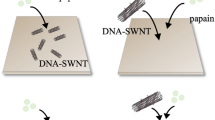Abstract
Using atomic force microscopy (AFM), the nature of the contact between a wide range of carbonbased nanomaterials (CBNs) and Escherichia coli cells is described and the consequences of such an interaction are estimated. It is shown that the contact of multiwall and a number of single-wall carbon nanotubes with the surface of a model microorganism carries a probabilistic nature and is not accompanied by changes in the morphology and viability of bacterial cells. The damage of the surface structures and the consequent destruction of Escherichia coli are observed upon contact with single-wall carbon nanotubes with low degrees of purification, which is presumably determined by the presence of technological impurities in CBNs. A significant enhancement of the affinity of C60 fullerenes functionalized by amine groups to the surface of model microorganisms, which also leads to the development of a bactericidal effect, is shown.
Similar content being viewed by others
References
A. Ya. Vul’ and V. I. Sokolov, “Investigation of Nanocarbon in Russia: From Fullerenes to Nanotubes and Nanodiamonds,” Ross. Nanotekhnol. 2(3–4), 17–30 (2007).
F. Gottschalk, T. Sonderer, R. W. Scholz, and B. Nowack, “Modeled Environmental Concentrations of Engineered Nanomaterials (TiO2, ZnO, Ag, CNT, Fullerenes) for Different Regions,” Environ. Sci. Technol. 43(24), 9216–9222 (2009).
R. H. Hurt, M. Monthioux, and A. Kane, “Toxicology of Carbon Nanomaterials: Status, Trends, and Perspectives on the Special Issue,” Carbon 44(6), 1028–1033 (2006).
S. Kang, M. Pinault, L. D. Pfefferle, and M. Elimelech, “Single-Walled Carbon Nanotubes Exhibit Strong Antimicrobial Activity,” Langmuir 23(17), 8670–8673 (2007).
S. Kang, M. Mauter, and M. Elimelech, “Physicochemical Determinants of Multiwalled Carbon Nanotube Bacterial Cytotoxicity,” Environ. Sci. Technol. 42(19), 7528–7534 (2008).
S. Kang, M. Herzberg, D. F. Rodrigues, and M. Elimelech, “Antibacterial Effects of Carbon Nanotubes: Size Does Matter!” Langmuir 24(13), 6409–6413 (2008).
E. A. Obraztsova, E. P. Lukashev, A. P. Zarubina, I. M. Parkhomenko, and I. V. Yaminsky, “Bactericidal Action of Single-Walled Carbon Nanotubes,” Vestn. Mosk. Univ., Ser. 3: Fiz., Astron., No. 3, 81–84 (2009) [Moscow Univ. Phys. Bull. 64 (3), 320–323 (2009)].
A. P. Zarubina, E. P. Lukashev, L. I. Deev, I. M. Parkhomenko, and A. B. Rubin, “Biotesting the Biological Effects of Single-Walled Carbon Nanotubes Using Bioluminescent Bacteria Test-System,” Ross. Nanotekhnol. 4(11–12), 152–155 (2009) [Nanotechnol. Russ. 4 (11–12), 871–875 (2009)].
C. Blaise, F. Gagne, J. F. Ferard, and P. Eullaffroy, “Ecotoxicity of Selected Nano-Materials to Aquatic Organisms,” Environ. Toxicol. 23(5), 591–598 (2008).
I. Velzeboer, A. J. Hendriks, A. M. J. Ragas, and D. van de Meent, “Nanomaterials in the Environment Aquatic Ecotoxicity Tests of Some Nanomaterials,” Environ. Toxicol. Chem. 27(9), 1942–1947 (2008).
V. S. Danilov, A. P. Zarubina, G. E. Eroshnikov, L. N. Solov’eva, F. V. Katashev, and G. B. Zavil’gel’skii, “Sensor Bioluminescent Systems Based on Lux-Operons of Different Types of Luminescent Bacteria,” Vestn. Mosk. Univ., Ser. 16: Biol., No. 3, 20–24 (2002).
S. Liu, L. Wei, L. Hao, N. Fang, M. W. Chang, R. Xu, Y. Yang, and Y. Chen, “Sharper and Faster “Nano Darts” Kill More Bacteria: A Study of Antibacterial Activity of Individually Dispersed Pristine Single-Walled Carbon Nanotube,” ACS Nano 3(12), 3891–3902 (2009).
K. Pulskamp, S. Diabaté, and H. F. Krug, “Carbon Nanotubes Show No Sign of Acute Toxicity but Induce Intracellular Reactive Oxygen Species in Dependence on Contaminants,” Toxicol. Lett. 168(10), 58–74 (2007).
V. K. K. Upadhyayula, S. Deng, G. B. Smith, and M. C. Mitchell, “Adsorption of Bacillus Subtilis on Single-Walled Carbon Nanotube Aggregates, Activated Carbon and NanoCeram™[superscript roman],” Water Res. 43(1), 148–156 (2009).
A. Simon-Deckers, S. Loo, M. Mayne-L’hermite, N. Herlin-Boime, N. Menguy, C. Reynaud, B. Gouget, and M. Carriere, “Size-, Composition- and Shape-Dependent Toxicological Impact of Metal Oxide Nanoparticles and Carbon Nanotubes toward Bacteria,” Environ. Sci. Technol. 43(21), 8423–8429 (2009).
Author information
Authors and Affiliations
Corresponding author
Additional information
Original Russian Text © D.G. Deryabin, A.S. Vasilchenko, E.S. Aleshina, A.S. Tlyagulova, H.N. Nikiyan, 2010, published in Rossiiskie nanotekhnologii, 2010, Vol. 5, Nos. 11–12.
Rights and permissions
About this article
Cite this article
Deryabin, D.G., Vasilchenko, A.S., Aleshina, E.S. et al. An investigation into the interaction between carbon-based nanomaterials and Escherichia coli cells using atomic force microscopy. Nanotechnol Russia 5, 857–863 (2010). https://doi.org/10.1134/S1995078010110169
Received:
Published:
Issue Date:
DOI: https://doi.org/10.1134/S1995078010110169




